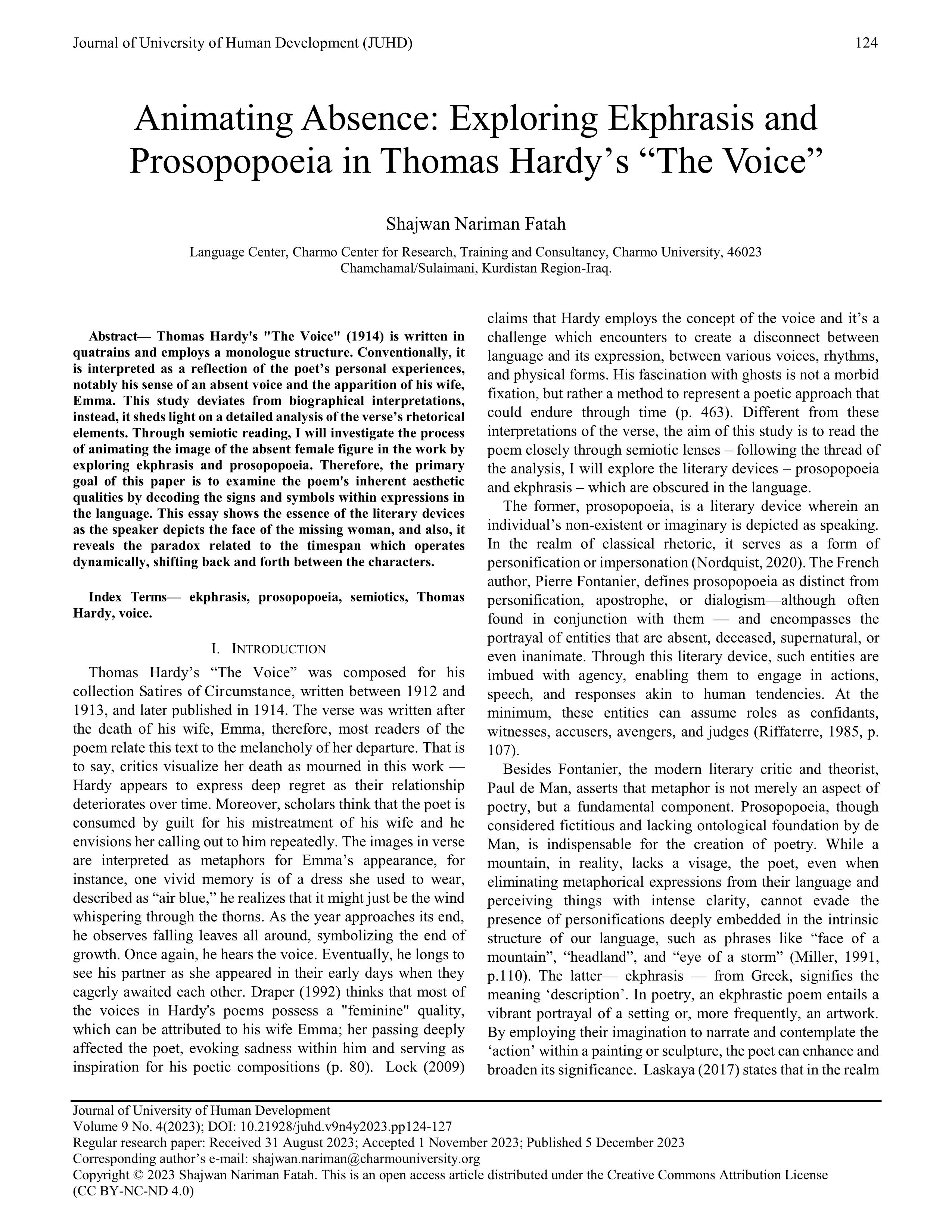Animating Absence: Exploring Ekphrasis and Prosopopoeia in Thomas Hardy’s “The Voice”
DOI:
https://doi.org/10.21928/juhd.v9n4y2023.pp124-127Keywords:
ekphrasis, prosopopoeia, semiotics, Thomas Hardy, voiceAbstract
Thomas Hardy's "The Voice" (1914) is written in quatrains and employs a monologue structure. Conventionally, it is interpreted as a reflection of the poet’s personal experiences, notably his sense of an absent voice and the apparition of his wife, Emma. This study deviates from biographical interpretations, instead, it sheds light on a detailed analysis of the verse’s rhetorical elements. Through semiotic reading, I will investigate the process of animating the image of the absent female figure in the work by exploring ekphrasis and prosopopoeia. Therefore, the primary goal of this paper is to examine the poem's inherent aesthetic qualities by decoding the signs and symbols within expressions in the language. This essay shows the essence of the literary devices as the speaker depicts the face of the missing woman, and also, it reveals the paradox related to the timespan which operates dynamically, shifting back and forth between the characters.
References
Abella, J., (2018, January 29). The Voice by Thomas Hardy. Poem Analysis. Retrieved from https://poemanalysis.com/thomas-hardy/the-voice/
A Short Analysis of Thomas Hardy’s ‘The Voice. (n.d.). Retrieved from Intersting Literature: https://interestingliterature.com/2017/06/a-short-analysis-of-thomas-hardys-the-voice/
Barthes, R. (1967). Elements of Semiology. New York: Hill and Wang.
Britannica, The Editors of Encyclopaedia. "semiotics". Encyclopedia Britannica, 24 Feb. 2023, https://www.britannica.com/science/semiotics.
Draper, R. P. (1992). The Feminine Voice in the poetry of Thomas Hardy. Thomas Hardy Society, 8(1), 71-83. Retrieved from https://www.jstor.org/stable/45274077
Ekphrasis. (2023). Retrieved from Poetry foundation: https://www.poetryfoundation.org/learn/glossary-terms/ekphrasis
Fatah, S. N. (2021). Representations of Trauma, Transference, Subaltern Discourse and Stockholm Syndrome In Sylvia Plath’s “Daddy”. Journal of Cultura and Lingua, 2(2), 96- 104. doi:https://doi.org/10.37301/culingua.v2i2.78
Goerke, Britta. "3.5. Thomas Hardy: “The Voice” (1912/14)". Facing Loss and Death: Narrative and Eventfulness in Lyric Poetry, Berlin, Boston: De Gruyter, 2016, pp. 99-106. https://doi.org/10.1515/9783110486339-015
Laskaya, A. (2017). The Art of Vision: Ekphrasis in Medieval Literature and Culture. Arthuriana, 27(4), 82-85. Retrieved from https://www.jstor.org/stable/26443705
Lock, C. (2009). Inhibiting the Voice: Thomas Hardy and Modern Poetics. A Companion to Thomas Hardy, 45-464.
Miller, H. J. (1991). Prosopopoeia in Hardy and Stevens. Tropes, Parables, and Performatives, 245-260. doi:https://doi.org/10.1515/9780822390688-017
Nordquist, R. (2020, January 10). Prosopopoeia: Definition and Examples. Retrieved from Thought Co. : https://www.thoughtco.com/prosopopoeia-definition-1691694
Riffaterre, M. (1985). Prosopopeia. Yale French Studies, 107-123. Retrieved from https://www.jstor.org/stable/2929928
Saussure, F. (2011). Course in General Linguistics. New York: Columbia University Press.
semiotics. Encyclopedia Britannica. (2023, 2 23). Retrieved from Britannica: https://www.britannica.com/science/semiotics
Semiotics. (n.d.). Retrieved from Online Etymology Dictionary: https://www.etymonline.com/word/semiotic#:~:text=1620s%2C%20%22of%20symptoms%2C%20relating,%22sign%22%20(see%20semantic)
The Voice. (n.d.). Retrieved from English with a smile: https://englishwithasmile.org/2016/06/02/line-by-line-analyis-of-the-voice-by-thomas-hardy/

Downloads
Published
How to Cite
Issue
Section
License
Copyright (c) 2023 Shajwan Nariman Fatah

This work is licensed under a Creative Commons Attribution-NonCommercial-NoDerivatives 4.0 International License.


